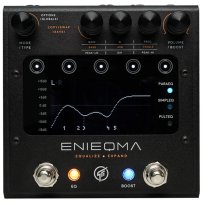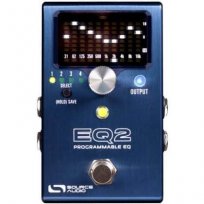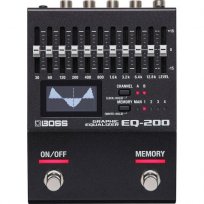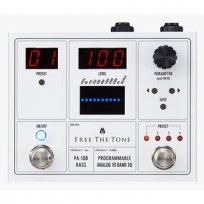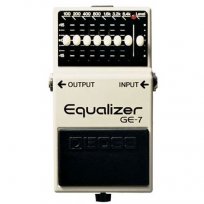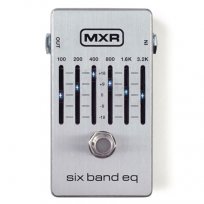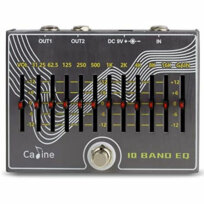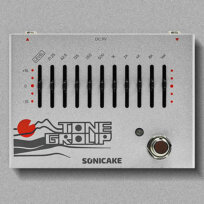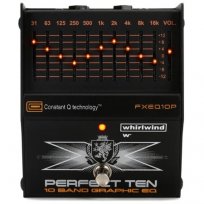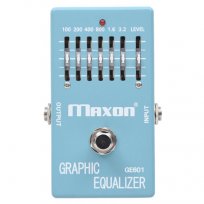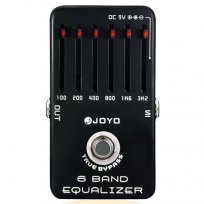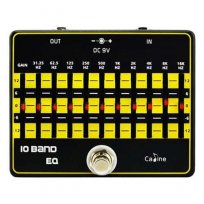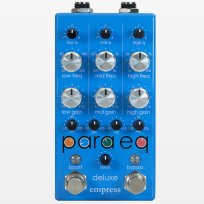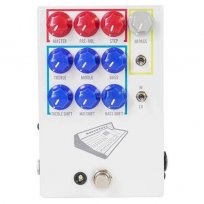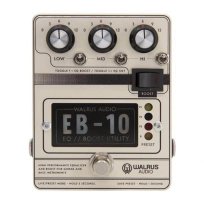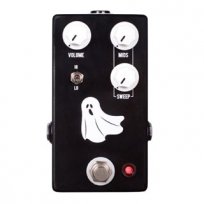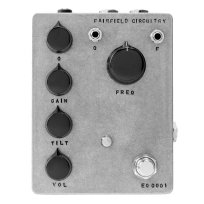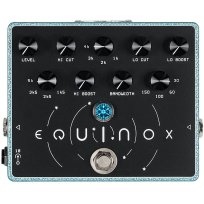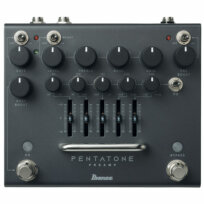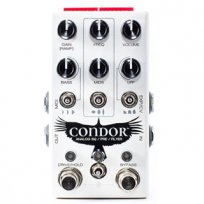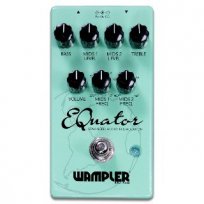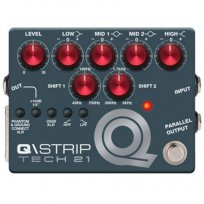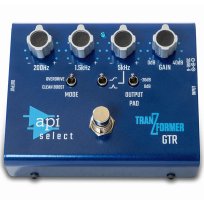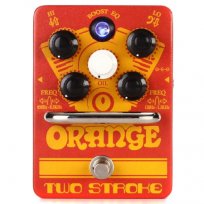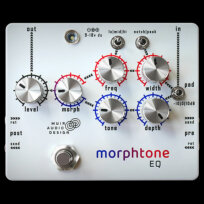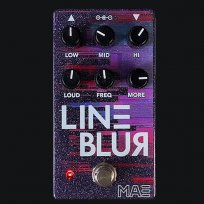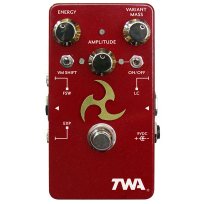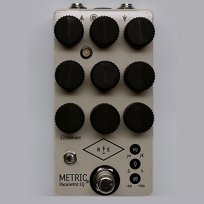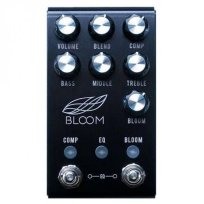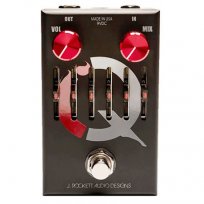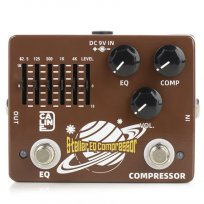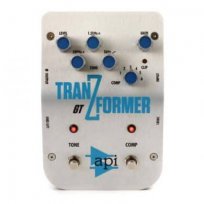Welcome to our article focused on the best EQ pedals for guitar, organized by features and price range. This article was updated on December 12, 2023.
—
EQ may not be the flashiest effect there is, but we’d be hard-pressed to find a pro guitarist who doesn’t tweak their EQ from song to song. Maybe that’s why an EQ pedal (graphic or parametric) is widely considered one of the best investments a guitarist can make to expand his or her range of tones.
EQ represents a fundamental element of your guitar sound, and while it’s true that good tone can be achieved without modifying your guitar/amp signal, it’s also undeniable that different sonic environments (read: songs) require different tones, and that’s where the pedals we cover in this article can come extremely handy.
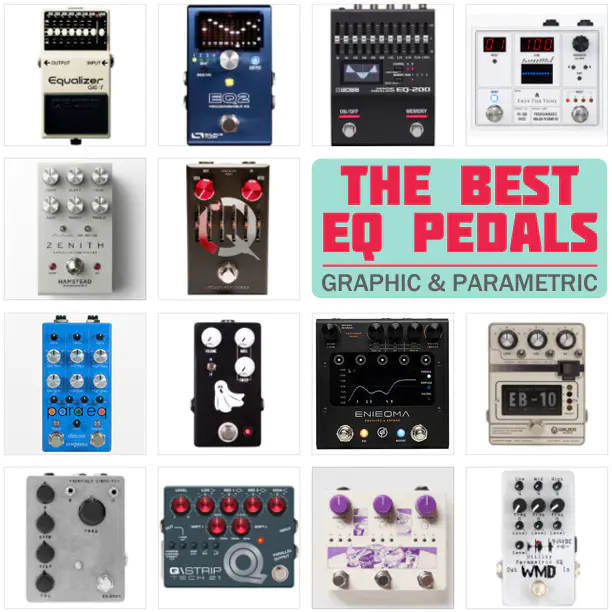
What’s an EQ Pedal and Why You Need One
A pedalboard is all about options, and an EQ pedal can, alone, broaden your sonic palette like no other effect – in particular when placed before your gain section.
Want your single-coil guitar to sound like it has humbuckers? Easy with an EQ pedal. Want to get a middle-position Strat sound with a Les Paul? Done. Want to kick on a mid boost for a solo without tampering with your high and low frequencies? Don’t overthink it, just get an EQ pedal, it opens up tonal options.
Different Types of Filters
EQ pedals are designed to boost or cut different frequencies of your signal. They use different types of filters to do this on a specific frequency range that can be set by the user.
These are the types of filters most commonly found in EQ pedals:
- Notch/Peak Filters are the type of filters most commonly found in the mixing consoles’ Parametric EQ strips. They cut or boost a specific frequency chosen by the user and leave the rest untouched. The most advanced filters of this kind also let you change the width of the selected frequency (aka “bell) through a parameter called Q. A small Q will almost chirurgically affect a very thin slice of frequency around the selected one, while a larger Q will affect a lot more frequencies, for a more natural sound. Notch/Peak filters are also found in Graphic EQs which are essentially a series of fixed filters affecting different frequencies.
- Low/High Pass Filters pretty much mute one side of the frequency spectrum starting from the selected frequency. A Low Pass will only allow through lows after the desired frequency, and filter out all the highs, and the High Pass will do the exact opposite. These filters can only drastically cut, they never boost nor attenuate. They are commonly used in synthesizers in conjunction with a Resonance filter.
- Low/High Shelf Filters are similar to the previous ones but they can boost or attenuate an entire range above or below a desired frequency.
- Not very common, the Bandpass Filter cuts any audio above and below a selected frequency range.
Along with compression, EQ is an essential studio tool that hobbyist guitarists have traditionally not thought about too much. But these days pedal designers are getting creative with packing studio-quality effects into stompboxes, giving players access to new tools for tone control that were never around before.
It is a new day for EQ pedals and guitarists everywhere! Here are the best guitar EQ pedals available right now.
Best Advanced EQ Pedals (Digital, Stereo)
This small list includes the last generation of graphic EQ pedals, all stereo, and powered by digital chips that allow flexibility unachievable through analog designs, including features like stereo EQ, presets, and Midi control.
GFI System Enieqma
a 3-mode EQ + Boost with graphic display, presets and deep functionality that can operate in stereo or dual mono. The 3 modes are 5-band Parametric, Simple EQ (with 7 different types available), and a Pultec mode. Combination mode lets you use Parametric along with one of the other modes. A Prototype EQ library lets you craft wahs, cab-sims, and more.
Source Audio EQ2 Programmable Equalizer
Offers a combination graphic and parametric equalizer with 10 fully adjustable frequency bands, stereo output, and an eight-preset system. Up to 12dB of boost. Additionally, EQs can be different for left and right channels, and there’s also a hidden tuner function! MIDI control provides up to 128 presets. The Neuro Desktop Editor & Mobile App gives players in-depth access to more parameters.
Boss EQ-200
This advanced EQ pedal goes above and beyond and acts like a real studio EQ. It features 2 channels of 10 EQ bands with 15db boost/cut that are visualized on the LCD screen and can be run in stereo, parallel, or series. 128 presets can easily be saved and recalled. It’s Midi compatible.
Free the Tone PA-1Q
Inspired by the analog circuit / digital control philosophy, Free the Tone has made a high-quality analog 10 band EQ with programmable parameters and presets. 12db of boost/cut and a wide frequency range from 50hz to 10khz. Switchable input from instrument to line level and midi in/out/thru for even more advanced control.
Best Analog Graphic EQ Pedals for Guitar
In this list, you’ll find the most popular graphic EQ pedals, all analog and strictly mono.
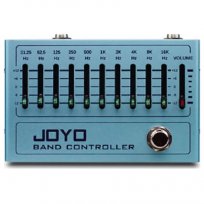
Boss GE-7
The classic EQ pedal found on the boards of countless pros. 7 bands with 15db boost or cut, ranging from 100hz to 6.4khz. Perfect as a tone shaper, boost pedal, or pickup emulator. There’s also a bass version of it (the Boss GEB-7) with a fuller frequency spectrum to accommodate the necessary deep low-end and articulate high-end control bassists want.
MXR Ten Band EQ
This hi-fi 10-band EQ can boost or cut 12db ranging from 30hz all the way up to 16khz. Noise reduction circuitry, 18v operation, and 2 separate outputs make this a flexible and powerful EQ pedal.
MXR Six Band EQ
This compact EQ pedal features six bands with 18db of boost or cut ranging from 100hz to 3.2khz in an elegant aluminum chassis. Six bands focused on the midrange should be more than enough to craft your perfect guitar tone.
Joyo R-12 Band Controller
This affordable 10-band EQ features an impressively wide frequency range from 30hz to 16khz. 12db boost or cut on each band and a master volume control. Will work equally well on guitar, bass, or synthesizers.
Caline CP-81 10 Band EQ
An affordable, stereo graphic EQ pedal that lets you tweak 10 frequency bands and that works well on both guitar and bass. A volume fader at the end of the chain and a gain one at the beginning, both pushing or cutting up to 12dbs, just like each EQ channel, give you extra tone-shaping options, since it can be used as an overdrive.
Mesa-Boogie Boogie
Based on the 5-band graphic EQ from their Mark II amp, this pedal is designed to be used in front of your pedal chain or in an amp’s FX loop for extreme tonal versatility and comes with input and output controls for gain matching anywhere in your signal chain. Get the coveted late 70s/80s mid-scoop sound on your pedalboard!
Whirlwind Perfect Ten
A high-quality graphic EQ from former MXR designers, the Perfect Ten ranges from 30hz all the way to 16khz with 12db of boost or cut. Its “Constant Q” design means that frequency width will always stay the same regardless of whether you are doing a small or large boost/cut. Runs at 18v for maximum headroom.
Sonicake Tone Group
A sub-$50 entry in the world of graphic EQ pedals from a Chinese builder that’s been getting some recognition for quality affordable pedals. It’s fully analog and offers ±15dB of boost or cut for a total of 10 frequency bands, and an overall volume knob placed before the EQ. At this price, it’s all in the tone, so make sure you hear it before you buy it.
Maxon GE601
Another compact 6-band EQ with 12db of boost cut per band, ranging from 100hz to 3.2khz, an ideal range for guitarists. Also comes with a master output and a high-quality JFET buffer.
Best Analog Graphic EQ Pedals Under $50
If your priority is not to break the bank, these graphic EQ pedals won’t do it.
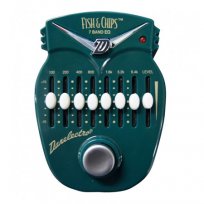
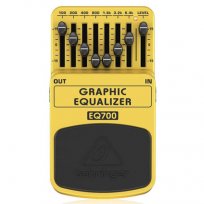
Danelectro Fish & Chips
Styled after the Boss. GE-7, the fish and chips is an affordable and effective EQ pedal. 7 bands with 15db of boost/cut ranging from 100hz to 6.4khz and a master volume.
Behringer EQ700 Graphic Equalizer
Another clone of the Boss GE-7, the EQ700 features the same 7 frequency bands and 15db boost or cut as the original, but at a $65 price point. Granted you’re gonna get a plastic enclosure and some corner-cutting on QC.
Joyo JF-11
A true bypass EQ pedal with an affordable price tag and 6 EQ bands strategically placed in a guitar-focused midrange, from 100hz to 3khz. 18db boost or cut.
Caline CP-24 10 Band Graphic EQ
The BOSS GE-7 is a very useful pedal to sculpt your tones, whether clean or distorted. Guitarists who want more than 7 EQ bands should take a look at this Caline CP-24, which offers a similar solution with a 10-band EQ, for under $40!!!
—
—
Best Parametric EQ Pedals
Most of the frequency content of the electric guitar lies in the mid-range, so it is important to have a lot of control over that sonic area. “Parametric mids” means that you can precisely select the frequency range of the mids you want to cut or boost. This is extremely useful for cutting through the live mix for a solo, or re-voicing your guitar pickup into a different sound.

Empress Effects ParaEQ Deluxe MkII
A compact pedal that gives you a console-style 3-band +/-15dB parametric EQ with an extra 30dB boost. Not only each channel is parametric, but three 3-way toggle switches let you choose the bell curve of the EQ’s boost/cut. The less popular but cheaper non-Deluxe version lacks the high/low cut filters and high/low shelving filters and features knobs instead of switches to control the Q values.
JHS Colour Box V2
A versatile pedal that allows guitarists to recreate the classic sound and tonal palette of a guitar plugged directly into the preamp of a Neve studio desk, while adding a second gain stage for dirty console fuzz. The in-depth EQ section features three Shift controls, which turn this circuit into a Fully Parametric EQ pedal. The Hi Pass section is enabled by the toggle switch below the white knob, which lets you cut low frequencies from 80Hz to 800Hz with a 6db per Octave slope. Other features include hi/lo gain switch, XLR in/out and the ability to pass phantom power to a mic.
JHS Haunting Mids
A simple yet effective mid-range-focused eq pedal for boosting/cutting the perfect amount of midrange frequencies. A sweepable parametric midrange control allows you to find the perfect EQ to slice through any mix or transform any amp or pedal into a totally different animal.
Wampler EQuator
There’s a heck of a lot that you can do to your tone just with EQ and frequency filter, and the Equator by Wampler is here to give you even more EQ options than your regular EQ pedal, with two parametric mid controls, with separate knobs for frequency and boost/cut. Bass and Treble are at fixed frequencies.
Walrus Audio EB-10
A utility stompbox with EQ and Boost that it lets you save up to three presets. The three switches by the EQ knobs can get them to boost or cut, while three internal trim pots allow to tweak the bell (or “Q”) of the mid EQ section and its center position (between 300H and 3kHz)
Tech21 Q-Strip
Inspired by the analog consoles of the 1960s and 70s, the Q-strip features an in-depth EQ section with a low shelf, 2 parametric mids controls, and high shelf. Also comes with lo and hi pass filters, a -20db pad, xlr and 1/4 inch outputs, and thruput. A very handy studio tool!
Fairfield Circuitry Long Life
An analog parametric resonant EQ channel with extra controls to saturate and dirty-up your tone, including an extra Gain stage. CV compatibility betrays its filter nature and the filter curve is variable, moving from lo-pass to band-pass to high-pass by turning the Tilt knob. Q controls the resonance, which is the amount of boost applied to the frequency, selected via the Freq knob. Two 1/8 inch CV In connections on the top of the case allow external control of these two parameters, while an Expression In will let you plug in an external rocking pedal for some old-school wah fun.
Ibanez Pentatone
Although it looks like a graphic EQ, this is a 5-band parametric EQ preceded by a preamp/distortion circuit with an extra 2-band EQ, and followed by a noise gate and a footswitchable clean boost. It also has a pre-boost knob to control the amount of signal going in the circuit. An external footswitch can be connected to trigger the pre-boost and 5-band EQ section.
Chase Bliss Audio Condor
Recently discontinued but very sought after (and expensive on the used market)., this is an EQ swiss army knife with a 100% analog signal path and digital controls and parametric boost/cut mids control from 150Hz to 5kHz with 3 “Q” settings. The Bass boost/cut control has 3 intensity settings. Low Pass Filter with 3 settings: normal, slight resonant, very resonant. A switch transforms it into an overdrive, and Ramping/Hold functionality creates LFO filter tremolo effects.
Orange Amps Two Stroke Boost/EQ
A clean boost/equalizer capable of up to 12dB of crystal clean boost through the “Oil” knob. The EQ section is semi-parametric, giving you a very flexible way to fine-tune your tone’s frequencies. There are 2 bands available that cover the most vital frequencies for guitar, a ‘Lo’ controlling the 120Hz – 1.2kHz range, and a ‘Hi’ which controls 850Hz – 8.2kHz range. Additional features include buffered bypass, and 18v operation level (most pedals run at 9v) for increased headroom and dynamics.
WMD Utility Parametric EQ
From a modular synth company, a stomp box with 3 bands of EQ with a huge range of 40hz to 15khz each. Separate controls for gain, frequency, and Q, as well as a master output volume knob.
Spaceman Effects Equinox
A reinterpretation of the legendary Pultec EQP-1a, optimized for electric guitar. It’s a hand-built multi-band, semi-parametric EQ with tons of headroom, carefully crafted gain staging and highly interactive frequency bands with interdependent cut and boost sections. Unlike the original, the Hi Boost and the Hi Cut knobs have separate rotary knobs selecting the center frequency (also optimized for guitar).
Ground Control Noodles Tone Shaper
Noodles is an original take on the tone-shaping box/boost pedal. Three EQ bands (Bass, Mids and Treble) each with its own footswitch, boost/cut knob, and a three-way push button that gives you a choice of frequency per band. If you add up all the possible frequency configurations, the Noodle gives you 64 ways to sculpt your tone.
API TranZformer GTR
Based on a Proprietary API 2510 OpAmp and featuring an API output transformer, the GTR offers up to 40dBs of Output volume to feed to your amp and +/-15dB of EQ at the crucial frequencies of 200Hz, 1.5kHz and 5kHz, with the latter featuring options for peak of high-shelf EQ. A toggle switch lets you choose between clean boost and overdrive mode.
Mask Audio Line Blur
An EQ with parametric mids with audiophile-grade op amps, tuned for guitar and bass. It can act as a clean boost when the three EQ controls are in neutral position, or a clean EQ when the two gain knobs (Loud and More) are down. Turning More up will add saturation to your input signal ranging from overdrive to distortion, and even fuzz when the EQ controls are turned up.
TWA Triskelion MkIII
A midrange booster with adjustable gain based on the vintage Systech Harmonic Energizer used by the likes of Frank Zappa, Greg Lake, Joe Walsh and other 70’s icons. Acting as a cocked wah pedal with an adjustable peak and a ton of gain, the Triskelion can do many things to your tone, by pushing different frequencies, just like a parametric mic EQ with adjustable Q would.
Revival Electric Metric
From the one-man operation Revival Electric in California, a unique 3-band EQ with fully parametric control over each band. Separate knobs for frequency, boost/cut, and Q with a +-20db range. Frequencies can be selected from 70 to 7khz. There is also a single-band version of this pedal with a sweep of 90hz to 1.1khz, focusing on the ever-important midrange.
Best Channel Strip-Style Pedals (EQ+Compression)
Pedal builders have started taking cues from pro recording gear and are creating studio-style “channel strips” in a box. Sometimes these have compressors or a preamp stage to control dynamics and color your tone. These can work as tone shapers early in the signal chain and many come with boosts to push into your next gain stage.

Jackson Audio Bloom
An LA2A-style Optical Compressor with a 3-band studio-grade EQ, the Bloom offers handy extra features like a Blend knob, Presets and Midi compatibility, and an original Boost/Sustainer circuit (“Bloom”) that ramps the volume of notes up to a set desired level.
Hamstead Soundworks Zenith Amplitude Controller
An EQ/Compressor/Boost designed to be a functional building block of your core tone. Compression has a parallel blend knob and EQ has 3 mid frequency options plus 3 different Q options for tailoring a mid peak to your specifications.
J. Rockett IQ Compressor
Combines a 6 Band Graphic EQ and compression into one pedal. The six band EQ covers 100Hz to 3.2 kHz. The compression part of the pedal is controlled by Volume and dry mix knobs. A simple an elegant tone shaper that works well at the beginning or end of your chain.
Caline DCP-10 Steller
Part of Caline’s dual pedal series, the left side is a 5 band EQ ranging from 62hz to 4khz plus a master volume. The right side is a simple compressor with knobs for tone, compression and volume. Each side can be independently switched.
API TranZformer GT
A high-end EQ+Compressor pedal from a pro audio company. The compressor is borrowed from their 525 feedback-style circuit and the 3 band EQ is styled after the legendary API 553 program equalizer. Polarity switches, a ground lift, and clipping LED round out the features.
—
Relevant Videos about EQ Pedals
How to Choose the Best EQ Pedals (Reverb.com)
Why You Need an EQ Pedal (JHS Show)
6 Ways to Use an EQ Pedal for a Better Tone (Wampler)
Yes, You Really Need an EQ (Rhett Shull)















